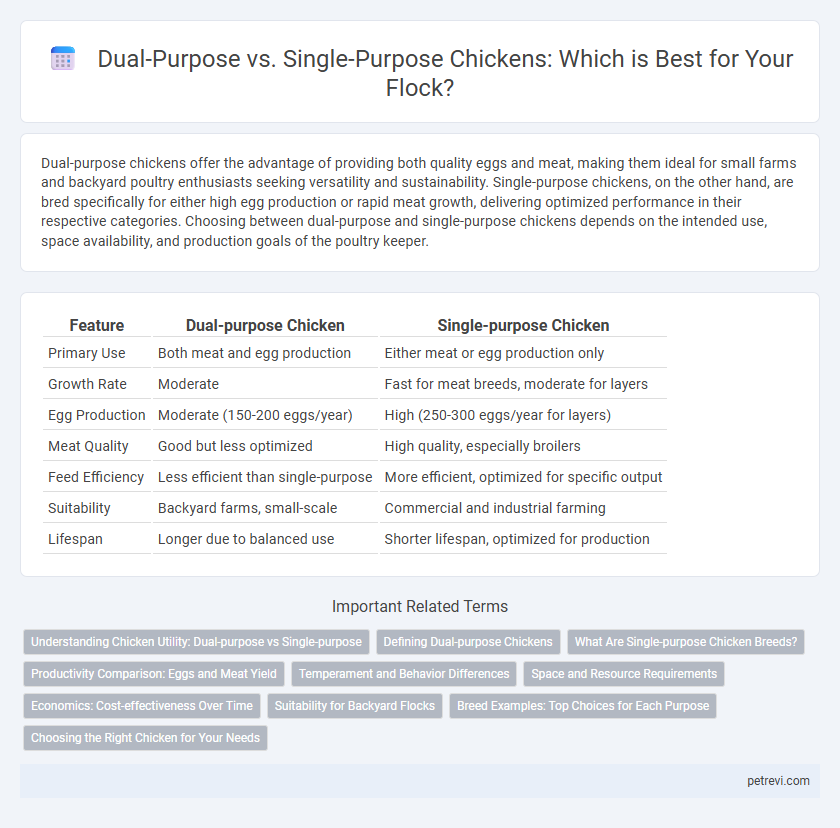Dual-purpose chickens offer the advantage of providing both quality eggs and meat, making them ideal for small farms and backyard poultry enthusiasts seeking versatility and sustainability. Single-purpose chickens, on the other hand, are bred specifically for either high egg production or rapid meat growth, delivering optimized performance in their respective categories. Choosing between dual-purpose and single-purpose chickens depends on the intended use, space availability, and production goals of the poultry keeper.
Table of Comparison
| Feature | Dual-purpose Chicken | Single-purpose Chicken |
|---|---|---|
| Primary Use | Both meat and egg production | Either meat or egg production only |
| Growth Rate | Moderate | Fast for meat breeds, moderate for layers |
| Egg Production | Moderate (150-200 eggs/year) | High (250-300 eggs/year for layers) |
| Meat Quality | Good but less optimized | High quality, especially broilers |
| Feed Efficiency | Less efficient than single-purpose | More efficient, optimized for specific output |
| Suitability | Backyard farms, small-scale | Commercial and industrial farming |
| Lifespan | Longer due to balanced use | Shorter lifespan, optimized for production |
Understanding Chicken Utility: Dual-purpose vs Single-purpose
Dual-purpose chickens are bred for both egg production and meat, offering balanced utility for small farms and backyard keepers. Single-purpose chickens specialize in either high egg yield, like layers, or rapid growth for meat, such as broilers, maximizing efficiency in commercial production. Choosing between dual-purpose and single-purpose breeds depends on the desired balance of egg quantity, meat quality, and farming goals.
Defining Dual-purpose Chickens
Dual-purpose chickens are breeds that efficiently provide both meat and eggs, balancing growth rate and egg-laying capacity. These chickens typically produce moderate quantities of quality eggs while also reaching a suitable market weight for meat production. Compared to single-purpose breeds specialized either for high egg yield or rapid meat growth, dual-purpose chickens offer versatile utility for small-scale and sustainable farming systems.
What Are Single-purpose Chicken Breeds?
Single-purpose chicken breeds are specifically developed for either egg production or meat yield, optimizing their genetics and physiology for one primary function. Egg-laying breeds such as Leghorns excel in high egg production with efficient feed conversion, while meat breeds like Cornish Cross are bred for rapid growth and substantial body mass. These breeds prioritize specialized traits, resulting in enhanced performance in their designated utility but limited versatility compared to dual-purpose chickens.
Productivity Comparison: Eggs and Meat Yield
Dual-purpose chicken breeds deliver moderate egg production, typically around 150-200 eggs per year, alongside reasonable meat yield, making them efficient for small-scale farms seeking both products. Single-purpose egg-laying breeds can produce over 250 eggs annually but have lower meat quality and yield due to lighter body weight. Conversely, single-purpose meat breeds exhibit rapid growth and higher carcass weight, often exceeding 3 kg at market age, yet they produce a minimal number of eggs, usually fewer than 100 per year.
Temperament and Behavior Differences
Dual-purpose chickens are valued for their balanced temperament, exhibiting calmness and adaptability suitable for both egg laying and meat production, while single-purpose breeds often display temperament traits optimized for their specific utility, such as the more docile nature of egg-laying hens or the assertive behavior of meat chickens. Behavioral differences also include activity levels, with dual-purpose breeds tending to be more active and resilient to environmental changes, whereas single-purpose breeds may exhibit specialized behaviors aligned with their production goals, like increased broodiness in egg layers. These distinctions influence management practices, affecting handling, housing, and overall flock dynamics in poultry farming.
Space and Resource Requirements
Dual-purpose chickens require more space and resources compared to single-purpose breeds, as they are raised for both meat and egg production, demanding facilities that accommodate varied growth and laying cycles. Single-purpose breeds, optimized either for egg-laying or meat production, typically need specialized environments that maximize efficiency, such as enriched cages for layers or concentrated feeding areas for broilers. Efficient resource allocation in dual-purpose systems involves balancing nutrition, housing, and management practices to support dual growth objectives without compromising productivity.
Economics: Cost-effectiveness Over Time
Dual-purpose chicken breeds offer cost-effectiveness by providing both eggs and meat, reducing the need for separate flocks and lowering overall production costs. Single-purpose breeds, optimized either for egg production or meat quality, often yield higher outputs in their specific area but require additional investment in parallel operations. Evaluating long-term economics, dual-purpose chickens enhance resource efficiency and profitability for small to medium farms with diverse needs.
Suitability for Backyard Flocks
Dual-purpose chickens excel in backyard flocks by providing both eggs and meat, making them highly versatile for small-scale or hobby farmers. Single-purpose breeds specialize in either egg production or meat quality, often delivering higher yields in their specific category but require more birds to cover diverse needs. For backyard settings, dual-purpose breeds like Rhode Island Reds or Plymouth Rocks offer a balanced solution, optimizing space and resources while meeting varied household demands.
Breed Examples: Top Choices for Each Purpose
Dual-purpose chicken breeds such as Rhode Island Red and Plymouth Rock excel in both egg production and meat yield, making them ideal for small farms and backyard flocks seeking versatility. Single-purpose breeds like Leghorns are specialized for high egg production, while Cornish Cross varieties dominate meat markets due to their rapid growth and substantial carcass size. Selecting the right breed aligns with specific goals, whether maximizing egg quantity or optimizing meat quality and growth rate.
Choosing the Right Chicken for Your Needs
Dual-purpose chickens provide both meat and egg production, making them ideal for small farms and backyard enthusiasts seeking versatility and cost-effectiveness. Single-purpose breeds specialize in either high egg production, like Leghorns, or rapid meat growth, such as Cornish Cross, catering to commercial operations with specific production goals. Selecting the right chicken depends on your priorities--whether maximizing egg yield, meat quality, or balancing both for self-sufficiency.
Dual-purpose vs Single-purpose for Chicken Utility Infographic

 petrevi.com
petrevi.com